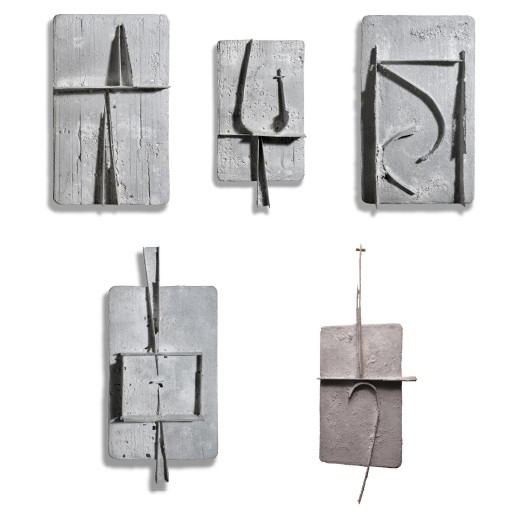Geoffrey Clarke, R.A. (b. 1924)
Square World I-V
5 aluminium reliefs
Conceived in 1959. This series is unique.
Square World I-V is a series of 5 aluminium reliefs which were commissioned for St Chad’s, Rubery, Birmingham, where they were installed but removed before consecration. Cast in 1959, they mark a significant moment in the development of 20th century British sculpture.
Clarke had been best known as a sculptor of forged iron. His work in that medium was exhibited at the famous 1952 Venice Biennale and identified him as part of that exciting ‘young’ generation of British sculptors which included Robert Adams, Kenneth Armitage, Reg Butler, Lynn Chadwick, Bernard Meadows, Eduardo Paolozzi and William Turnbull.
During the 1950s Clarke’s searching creativity began to investigate material and form, and in a moment of some significance for British sculpture, attracted by the lightness and modernity of the material, he produced sculptures in aluminium.
The first works in aluminium were open-cast reliefs, among them the Square World series. These reliefs are bold linear designs expressing the meeting point of the celestial and terrestrial.
Clarke has devoted a great deal of his career to religious commissions, including works for Coventry Cathedral (1953-62). His commissions are praised for their successful combination of modernity within a religious setting. It is interesting to note that Clarke’s father was an architect and his grandfather a church furnisher. An enduring childhood memory of the artist is accompanying his grandfather on business trips to sell church fittings: candlesticks or the occasional stained glass window.
Square World I-V is hugely important in the development of Clarke’s work. Clarke received the greatest number of public commissions than any other post-war sculptor and as such his work would have been highly influential. Artists who moved to aluminium included Eduardo Paolozzi and Hubert Dalwood. It has been stated that Clarke’s development “transformed sculpture from the wounded verticality of 1950s figuration to the colourful horizonality of Caro and the New Generation, seen at the Whitechapel Art Gallery in 1965” (see J. LeGrove, Geoffrey Clarke, A Decade of Change, London, 2013, p. 5).


